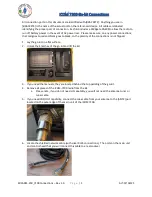
Print Date 04/01/11 Page 21 of 42 E2165-00MA-04
2.2.6 Composite Output Connector (and Loop Switch)
This is a 75
Ω
BNC coaxial socket SK10 at the lower rear of the unit used for interconnection to
external equipment, typically for RDS insertion, after which it is routed back to the Exciter’s Composite
Input Connector (see 2.2.5) and thence to the modulator.
In this situation, the rear panel ‘Loop‘
switch SW01 must be in the lower ‘Ext’ position
. A 50
Ω
or 75
Ω
BNC plug can be used for
connection to this output, with matching screened coaxial cable, not exceeding three metres in length.
This output can only be sourced from an optionally fitted module which has a composite/mpx output,
such as the /S Stereo Encoder. It cannot be sourced from the composite/mpx signal directly applied to
the modulator within the Exciter.
When the composite/mpx signal from the optionally fitted module is to be routed directly to the
modulator, the rear panel ‘Loop‘ switch SW01 must be in the upper ‘Int’ position.
This is the
normal mode of operation.
The output is unbalanced 75
Ω
, at a level, for
±
75kHz deviation, of 5.5V peak to peak (open circuit).
This matches the input sensitivity of the Exciter’s Composite Input Connector (see 2.2.5) when the
external equipment has nominally 0dB insertion gain and all input impedances (external equipment
and Exciter’s Composite input) are set to high.
2.2.7 TCP/IP Connector
This is an RJ45 connector SK04 fitted at the rear of the unit. This enables all the control and
monitoring detailed in Section 2.4 to be performed using TCP/IP (Transmission Control/Internet
Protocol).
This arrangement requires the unit to be assigned a unique Internet Protocol address. When first
connected to the network via its RJ-45 connector, the Exciter’s TCP/IP adapter will attempt to acquire
an IP address automatically (it’s quite common to have networks configured to use ‘DHCP’, which
provides these addresses on demand). The address to which a device has been assigned can then be
determined and, if required, be overridden with a desired fixed value, using Eddystone supplied
software.
Note that an internal lead connection determines if serial control and monitoring is via this RJ45
connector or via the rear panel (RS232) COM Port connector PL11 (see 2.2.12). For TCP/IP control,
the 3 pin screened lead from the Front Panel board connector (6)CON05 must be plugged into the
Main Board connector (5)CON07 (see E2165-00CT).
2.2.8 Baseband Monitor Connector
This is a 50
Ω
BNC coaxial socket SK01at the left hand side of the Exciter front panel. This provides a
sample of the signal applied to the modulator within the Exciter. The output is unbalanced 75
Ω
, at a
level, for
±
75kHz total deviation, of 1.6V peak to peak (pd across 75
Ω
). This connector is for test
purpose only with the test equipment and lead being disconnected when not in use.
NOTE that the
performance of this output (noise/distortion/stereo separation etc.) is not necessarily equal to
that of the modulated signal.
2.2.9 RF Monitor Connector
This is a 50
Ω
BNC coaxial socket SK02 on the left hand side of the Exciter front panel. This provides
an harmonically filtered sample of the Exciter’s forward output power at a level, into 50
Ω
,
approximately 54dB below the power being delivered into the load (e.g. approximately 0.5 to1mW at
maximum power output). This connector is for test purpose only with the test equipment and lead
being disconnected when not in use.
NOTE that the levels of any harmonics present are not
necessarily equal to those at the antenna.
















































